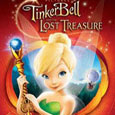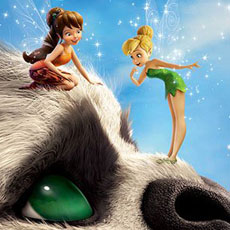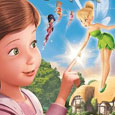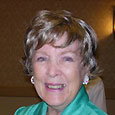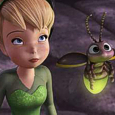DisneyToon Studios (2008), Walt Disney Home Entertainment (October 28, 2008), 1 disc, 78 mins plus supplements, 1.78:1 ratio, Uncompressed PCM and Dolby Digital 5.1, Rated G, Retail: $34.99
Image Note: the still frames used in this article are for illustrative purposes only and should not be regarded as representative of the transfer on this Blu-ray Disc release.
Storyboard:
The pixie from Peter Pan comes into being, but though she is mesmerized by the beauty of Pixie Hollow, she is unsatisfied with the role she is given. Trying hard to find her true calling, she makes mistakes but ends up being an inspiration to her friends.

The Sweatbox Review:
I try hard not to be a cynic, but we must start off this review by acknowledging that this movie was initially purely the creation of the Disney marketing department. With the “Disney Princess” brand generating literally billions of dollars from parents of young girls, it was natural for Disney executives to wish to find a way to further exploit the buying wants of these maturing girls and their older sisters. They came up with “Disney Fairies,” a brand that was set to take the world of “tweens” by storm in 2006, and was to be given a major boost by the Fall 2007 release of a movie starring Tinker Bell. Only, that movie didn’t make it out in October 2007 as planned. As early as the Christmas before, Disney executives decided to push the release date back. In fact, it ended up coming out a whole year behind schedule, making it a bit of a nightmare to those same marketing reps who had promised toy makers, publishers, and other manufacturers that the Tinker Bell movie would be at the center of the marketing storm. Products were already on the shelves, with no movie to promote the line. Whoops. Estimates at the time pegged the potential loss to be as much as a half a billion dollars in lost sales. Disney Consumer Products could not have been happy.
The reason for all this was that Tinker Bell And The Ring Of Belief, as it was known at one time, just wasn’t coming out all that good. Rumor has it that the main fellow pulling the trigger on the postponement was new Disney Animation head John Lasseter, who was very concerned that the story still needed major work. Worst of all from a marketing perspective, the developing film looked like it would appeal to only the very young, and not the hipper 8-12 year old girls that were supposed to love it. This was obviously a major problem, since much of the future success of the Disney Fairies line, not to mention the three planned Tinker Bell sequels, hinged on tween girls buying and loving the first movie. So, it looked like the lesser evil in this case would be to postpone the movie’s release date while the story and execution were overhauled.
So, did it work?
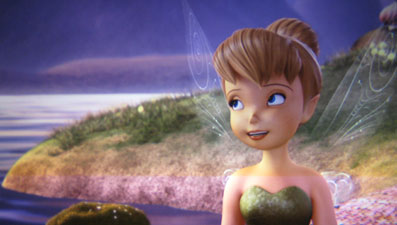
It remains to be seen if other merchandise sales take a jump with the movie release, but I can tell you that the movie itself turned out pretty good. Not once does it feel like the product of heavy script revisions, nor does it appear rushed in any way. The animation is extremely good, and direct-to-video naysayers will have an argument from me if they want to portray this as cheap looking or amateurish, though it must be conceded that a theatrical feature budget would have certainly added to the impressiveness of the animation. The figures definitely look doll-like, but I have the same issue with most other CGI features too. There are only occasional instances, and always quite brief, where a character should have had a little more care taken in the animation of a scene — you know, like when all fingers of a hand move too much the same, or a torso turns as a block rather than segmentally. To me, this is a core issue with CGI animation; when a figure isn’t being drawn from scratch each frame or two, and is instead basically a virtual puppet being manipulated, there are just so many things that can be missed in terms of joint movement. That’s a CGI issue, though. Another typical issue is that of hair — unlike, say, Sully in Monsters, Inc., the characters in Tinker Bell have hair that moves in blocks, more similar to how Barbie appears in her CGI movies. Tinker Bell herself certainly looks better once her hair is put up in a bun. However, overall, Tinker Bell’s quality is such that it is not all that far behind the achievements (animation-wise) of Meet The Robinsons. That’s a pretty fair comparison, really, as Robinsons also had a rounded, fanciful design aesthetic. Neither of these movies were meant to be at all photo-realistic, so I don’t want to hear anyone complaining that Tinker Bell doesn’t look as “real” as Wall*E.
Even aside from the character animation, the backgrounds are detailed and the characters are appealing in their designs. The fact that the fairies look like dolls probably works to their advantage when considering marketing potential, but they are also pretty cute. Actually, I still wonder if they maybe aren’t too cute for the target audience. I would expect tweens to have a little more attitude, but maybe they’ll at least be drawn to the “bad girl” in the story. And speaking of the story…
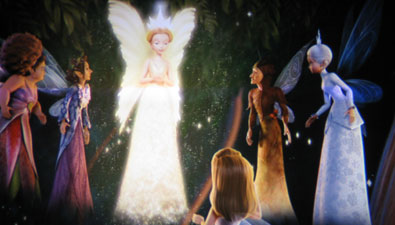
Tinker Bell is born out of the laughter of a baby, and her essence travels to Pixie Hollow, in the heart of Never Land, where she is brought fully to life. She soon undergoes a ritual that all new fairies do, when a magical ceremony takes place under the supervision of Queen Clarion, a ritual that sees the new fairy given a designation that will determine her responsibilities in Pixie Hollow. It turns out that this fairy is to be a “tinker,” though she does not immediately understand the implications. Signs point to her being a rare talent, though, and this is enough to elicit the jealousy of Vidia, who herself is known for being a gifted and speedy flyer.
Fortunately, Tinker Bell also immediately gains friends, including the male tinkers Clank and Bobble. Though fond of these two, her closest friends come to be several “nature fairies,” fairies who are responsible for guiding nature in its usual processes. These friends include a garden fairy named Rosetta, a water fairy named Silvermist, a light fairy named Iridessa, and Fawn, an animal fairy. Each type of fairy has a job to do, with the busiest times being when the seasons change on The Mainland, their term for our world. Spring is approaching, so preparations are well underway, and Tinker Bell is expected to participate as soon as she is oriented to being a tinker. Unfortunately, it turns out that Tinker Bell does not feel well suited to being a tinker, and initially she appears to have very little talent at it. Tinkers are makers of things — various devices and tools that the other fairies can use. She is already just barely tolerating her lot in life when she learns that tinkers are not allowed to go to The Mainland, which she sees as a crushing disappointment.

This leads to her decision to become a different type of fairy, but this tactic is greeted by a mixture of skepticism and outright fear by her friends. Nevertheless, they endeavor to help her train to be something that she was never intended to be — a non-tinker. Naturally, the results are not good, as Tinker Bell tries to develop talents she simply doesn’t have, while denying herself the use of the talent that she was born with; for it turns out that she has a marvelous ability to assemble things and invent new devices. In short, she is a master tinker. Her plans go further awry when Vidia intervenes to further disrupt things and make Tinker Bell look bad. In order to correct all her mistakes, Tinker Bell must accept who she is and use her gifts to her best ability.
It’s a positive message overall, though somewhat at odds with what is a common theme of many other animated films. In those films, we are taught to ignore the expectations of others and pursue our dreams. Here in Tinker Bell, it seems we are to abandon our dreams in order to be what others expect of us. I suppose that in real life, we simply must choose the best path, regardless of who put us on it. In the case of Tinker Bell, she must realize that her pre-determined job is really what suits her best and gives her the best chance for happiness. In the end, what’s important is that we all can find some meaning in our existence.
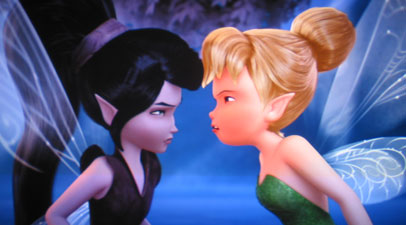
Disney made a bit of fuss over Tinker Bell having a speaking role in this movie, but Mae Whitman’s voice sounds pretty generic “Disney princess” to me. When Tinker Bell utters her first lines of dialog, it’s hardly an exhilarating moment. It’s fine, really, and Whitman does do a nice job of making Tink endearing, but the advertising that emphasized Tink’s voice shouldn’t have overplayed it. It is a bit odd to see her speaking, given that she is mute in Disney’s 1953 film Peter Pan, but this is not the only clue that they are different characters. Oh, we are to believe that Tinker Bell is a prequel to Peter Pan, but she acts entirely different here. The jealous, scheming Tink of Peter Pan here gives way to a cute, plucky young lady who would seemingly not harm a fly. If we are to rectify things, we could say that there must be years separating the two versions, such that Tink has not yet developed her true personality yet, something which may have eventually been triggered by meeting Peter Pan. An apparent peek at a character from Peter Pan at the end of Tinker Bell may hinder this hypothesis, though, and on the whole I would suggest just enjoying Tinker Bell as a whole separate enterprise. But this is an argument for older fans, and not the target audience.
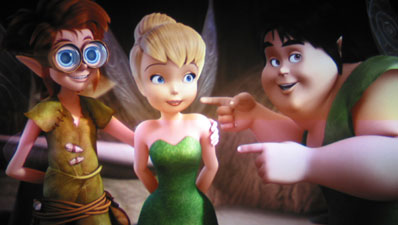
Young girls should fall in love with the inhabitants of Pixie Hollow. The world is extremely well realized, with a level of detail that can only be appreciated with multiple viewings. Look closely, and you will see how all items in this world were made from nature. There was a lot of design work that went into this movie, and the work that was done certainly helps to create a believable world. The ideas presented — a queen fairy, ministers of seasons, the pixie dust tree, and much more — are sure to appeal to the imaginations of kids, and even I found the ideas enchanting. (Apparently much of the inspiration for this came from Disney Press’s 2006 book In The Realm Of The Never Fairies: The Secret World Of Pixie Hollow, by Monique Peterson.) My main complaint about the world that was created would be that so many of the inhabitants are dull. It’s forgivable with secondary characters to have one-note personalities, but even Tink’s female friends seem fairly interchangeable, except for their skin shades. Hopefully, personalities will be better addressed in future movies. It is expected that this movie is laying the groundwork for an adventure trilogy.
Tinker Bell is definitely best suited for its target audience, but it’s better than you would expect, and certainly it exceeds expectations based on its troubled history. The postponement of its release was truly worth it, as the Disney people have managed to bring to life a charming tale set in a magical world that should make the movie a hit with little girls. This certainly has to rank among the better of the made-for-video efforts from Disney.
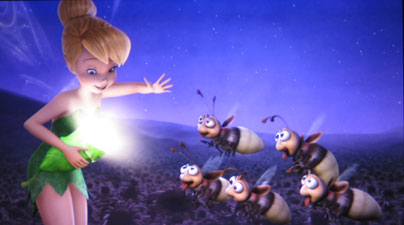
Is This Thing Loaded?
When the Blu-ray loads, you are prompted to decide whether to download the BD-Live components, which on my PS3 took a minute or two. The BD-Live features include online chat capability while the movie plays, video e-mails synched to a specific scene, and options to getting Disney Movie Reward points that can be redeemed for virtual prizes. You must then register for BD-Live over the Web. You can also view a promo on the Blu-ray explaining the BD-Live options. Disney is really pushing these features, though I know I’ll never use them myself.

The disc then plays skippable Disney and Disney Blu-ray promos, as well as Trailers for Pinocchio on Blu-ray (looks fantastic to me), Bolt, and Tinker Bell And The Lost Treasure, as well as the Disney Movie Rewards promo. From the menu, Wall*E and Space Buddies trailers can also be viewed, along with promos for the Pixie Hollow website and an ad for the Disney parks. All of the extras on the Blu-ray, by the way, are shown in HD.
In Magical Guide To Pixie Hollow (6:10), Tinker Bell narrates a series of explanations about how the society of Pixie Hollow works, the features of the locales there, and the roles of each type of fairy. This actually did help to flesh things out better, though much could be guessed at by watching the movie.
Tinker Trainer is a game where you have to perform a series of tasks to become a professional fairy. I actually found these quite challenging. Maybe I’m too old? Even though I was a failure at the game, they were nice enough to congratulate me after each task anyways, which was polite. (According to the information Disney supplied for this review, this feature is a DVD-ROM feature on the standard DVD.)
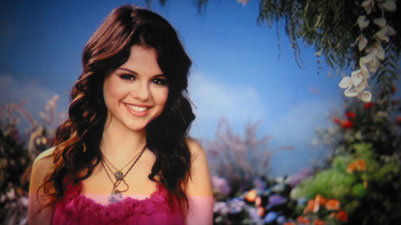
Disney Channel child star Selena Gomez appears in a Music Video (3:14) for Fly To Your Heart. I confess I liked the song and the music video — Gomez has personality and a strong voice.
Ever Wonder? (3:55) shows fairies in a live action environment affecting the natural word and helping out humans. For kids, this is a nice little mini-movie.
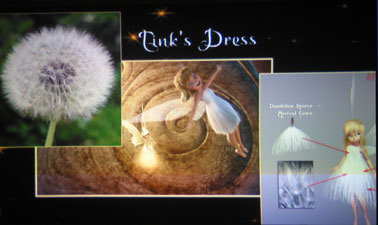
Creating Pixie Hollow (10:15) is hardly a full-length “Making of,” but John Lasseter, along with the screenwriter, art director, and others do a nice job of describing what went into producing the movie and creating the world of Pixie Hollow. It certainly gave me a deeper appreciation for all the creativity that went into the movie; there were so many little details that I took for granted, but were actually quite inspired.
There are over ten minutes of Deleted Scenes, in addition to introductions and explanations by director Bradley Raymond and producer Jeannine Roussel. The first two are fully animated, while the remaining four are in the storyboard phase, presented with cast audio.

Case Study:
Standard Blu-ray case, with insert for Disney Movie Rewards and a “Magical Savings” booklet. The booklet also includes information on getting the most out of a high definition home theater, as well as the disc’s BD-Live capabilities. There was no slipcover on my review copy, although the DVD got one.
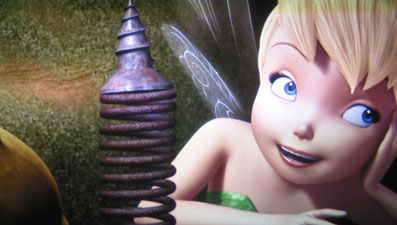
Ink And Paint:
It’s a Disney Blu-ray with a digital-to-digital transfer done at 1080p, so it should come as no surprise that the video is pretty much perfect. The color depth is impressive, shadow detail is good, and there are of course no compression issues. As with the best high-def transfers, it looks like I could walk into my TV and join the world shown in the movie.
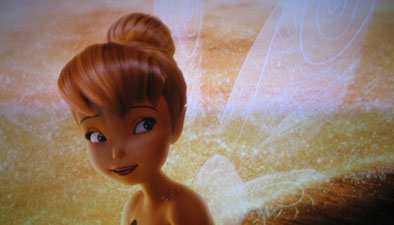
Scratch Tracks:
Disney offers two versions of the English language track on the Blu-ray, in uncompressed PCM, as well as Dolby Digital 5.1. The PCM track is 48kHz, 24-bit. Regrettably, I haven’t upgraded by receiver to accommodate lossless audio, but the 5.1 track does do a good job of bringing Pixie Hollow to audible life. More bass is present than one might expect, though the use of rear surrounds is generally modest. Of course, this is a little girls’ movie and not an action film, so all things considered I was impressed. Note that the DVD also has French and Spanish tracks, which are absent on the Blu-ray. There are also only English subtitles on the Blu-ray.
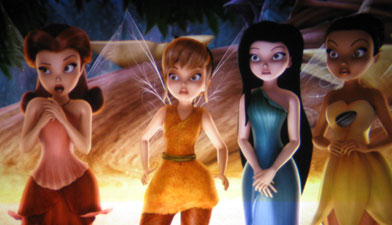
I’ll mention the voice cast here while I’m dwelling on the audio presentation. Disney attracted an impressive array of talent for this direct-to-video feature, including Mae Whitman, America Ferrera (Ugly Betty), Raven-Symone, Kristin Chenoweth, Lucy Liu, Kathy Najimy and even Oscar winner Angelica Huston (sounding surprisingly elegant as Queen Clarion).
Final Cut:
This is just the type of film that the male adult animation fan would be very prepared to skewer, but I have bad news for those that would like crucify what they haven’t seen. Tinker Bell is really a good little movie. The narrative is kept simple enough for younger audiences, yet stays involving enough to keep an adult viewer’s attention. The best part of it, aside form the obvious eye candy, is likely the development of the world of Pixie Hollow, which shows obvious attention to detail and a creative developmental process. I’m not sure that the movie manages to transcend its target of appealing to the tween and little girl set, but as a representative of its particular genre, it is exemplary — and certainly good enough that Disney buffs will at least want to give it a rent. Just don’t worry too much about how it ties in with Peter Pan; this movie stands better on its own. With future instalments promising more adventure, I am curious enough to want to see how they turn out. The next one will be entitled Tinker Bell And The Lost Treasure.
The Blu-ray of Tinker Bell features cutting-edge video and audio, as well as the latest innovations in BD-Live interactivity. If you have a little girl and a sweet home theater set-up, definitely go for the Blu-ray.
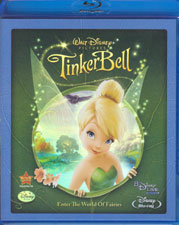 | ||
 |







